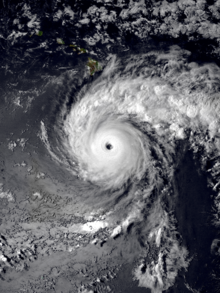
Back Hurikán John (1994) Czech Hurrikan John German Huracán John (1994) Spanish Ouragan John (1994) French John hurrikán (1994) Hungarian 平成6年台風第20号 Japanese Furacão John (1994) Portuguese Джон (ураган) Russian Hurricane John (1994) SIMPLE Bagyong John (1994) Tagalog
 John near peak intensity to the south of Hawaii on August 23 | |
| Meteorological history | |
|---|---|
| Formed | August 11, 1994 |
| Extratropical | September 10, 1994 |
| Dissipated | September 13, 1994 |
| Duration | 4 weeks and 2 days |
| Category 5 major hurricane | |
| 1-minute sustained (SSHWS/NWS) | |
| Highest winds | 175 mph (280 km/h) |
| Lowest pressure | 929 mbar (hPa); 27.43 inHg |
| Overall effects | |
| Fatalities | None reported |
| Damage | $15 million (1994 USD) |
| Areas affected | Hawaiian Islands, Johnston Atoll, Aleutian Islands, Alaska |
| IBTrACS | |
Part of the 1994 Pacific hurricane and typhoon seasons | |
Hurricane John, also known as Typhoon John, was the farthest-traveling tropical cyclone ever observed worldwide. It was also the longest-lasting tropical cyclone on record globally at the time, until it was surpassed by Cyclone Freddy in 2023.[1] John formed during the 1994 Pacific hurricane season, which had above-average activity due to the El Niño of 1994–1995,[2] and peaked as a Category 5 hurricane on the Saffir–Simpson scale, the highest categorization for hurricanes.
Over the course of its existence, John followed a 13,180 km (8,190 mi) path from the eastern Pacific to the western Pacific and back to the central Pacific, lasting 31 days in total.[3][4][5] Because it existed in both the eastern and western Pacific, John was one of a small number of tropical cyclones to be designated as both a hurricane and a typhoon. Despite lasting for a full month, John barely affected land at all, bringing only minimal effects to the Hawaiian Islands and the United States military base on Johnston Atoll. Its remnants later affected Alaska.
- ^ Cite error: The named reference
wmoprwas invoked but never defined (see the help page). - ^ "Cold and Warm Episodes by Season". August 4, 2014. Retrieved August 11, 2014.
- ^ Lawrence, Miles (1995). "Hurricane John Preliminary Report (page 1)". NOAA. Retrieved May 22, 2006.
- ^ Dorst, Neal (2004). "What is the farthest a tropical cyclone has traveled?". NOAA Tropical cyclone FAQ. NOAA. Archived from the original on May 6, 2009. Retrieved May 22, 2006.
- ^ "Tropical Cyclone: Longest Distance Traveled by Tropical Cyclone". World Meteorological Organization. Retrieved March 9, 2023.